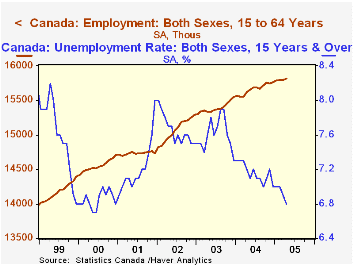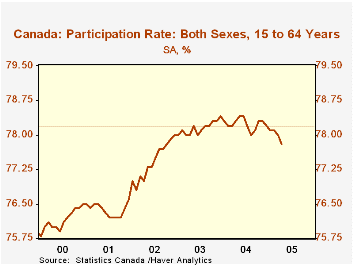 Global| May 06 2005
Global| May 06 2005Some Employment Gains in Canada, But Lower Unemployment Reflects Reduced Participation
Summary
The Canadian economy also experienced job growth in April, with a total employment gain of 29,300, following a slim 4,400 rise in March. The great part of the April move was in service industries, as the number of workers in the goods [...]

The Canadian economy also experienced job growth in April, with a total employment gain of 29,300, following a slim 4,400 rise in March. The great part of the April move was in service industries, as the number of workers in the goods sector held just about steady. From a year ago, employment increased 1.4%, indicating some slowing after a 2% average annualized rate of increase over the past three years.
In the goods sectors, April's flat result was the net of a nearly offsetting rise in construction jobs and fall in manufacturing. These same two have maintained this kind of pattern over the last year as well. In service industries, firm uptrends are evident in trade, finance, professional services and education. Transportation, health care and accommodations and food service are losing jobs, although the declines in the latter two are quite modest. 
The unemployment rate in Canada has continued its declining trend begun in late 2003. The 6.8% in April is the lowest since the same level in December 2000. While this might suggest recent strength in the Canadian labor market, optimism must be tempered by the fact that employment growth has been slower. In fact, the inroads on the reported unemployment rate come from lower labor force participation. While employers are adding new jobs at a slower pace, people are pulling back somewhat from wanting jobs in the first place. This is reflected in the reduction in the participation rate by 0.4% from its 2004 average of 78.2% of the working-age population to 77.8% in April. Had participation remained at that level, calculations indicate that the labor force would have been nearly 80,000 larger in April and the resulting unemployment rate would not have declined.
| Canada | Mo/Mo Change, 000sYr/Yr % Apr 2005 | December/December|||||
|---|---|---|---|---|---|---|
| Apr 2005 | Mar 2005 | 2004 | 2003 | 2002 | ||
| Employment* | 29.3 | 4.4 | 1.4% | 1.5% | 1.9% | 4.0% |
| Goods - Producing* | 0.4 | 10.8 | 0.7% | 2.0% | -0.5% | 6.3% |
| Service - Producing* | 28.9 | -6.3 | 1.5% | 1.2% | 2.6% | 3.1% |
| Labor Force** | -5.6 | -8.2 | 0.7% | 1.1% | 1.6% | 3.2% |
| Unemployment Rate** | 6.8% | 7.0% | Apr 2004 | Annual Average | ||
| 7.3% | 7.2% | 7.7% | 7.7% | |||
| Participation Rate** | 77.8% | 78.0% | 78.3% | 78.2% | 78.1% | 77.4% |
Carol Stone, CBE
AuthorMore in Author Profile »Carol Stone, CBE came to Haver Analytics in 2003 following more than 35 years as a financial market economist at major Wall Street financial institutions, most especially Merrill Lynch and Nomura Securities. She had broad experience in analysis and forecasting of flow-of-funds accounts, the federal budget and Federal Reserve operations. At Nomura Securities, among other duties, she developed various indicator forecasting tools and edited a daily global publication produced in London and New York for readers in Tokyo. At Haver Analytics, Carol was a member of the Research Department, aiding database managers with research and documentation efforts, as well as posting commentary on select economic reports. In addition, she conducted Ways-of-the-World, a blog on economic issues for an Episcopal-Church-affiliated website, The Geranium Farm. During her career, Carol served as an officer of the Money Marketeers and the Downtown Economists Club. She had a PhD from NYU's Stern School of Business. She lived in Brooklyn, New York, and had a weekend home on Long Island.





